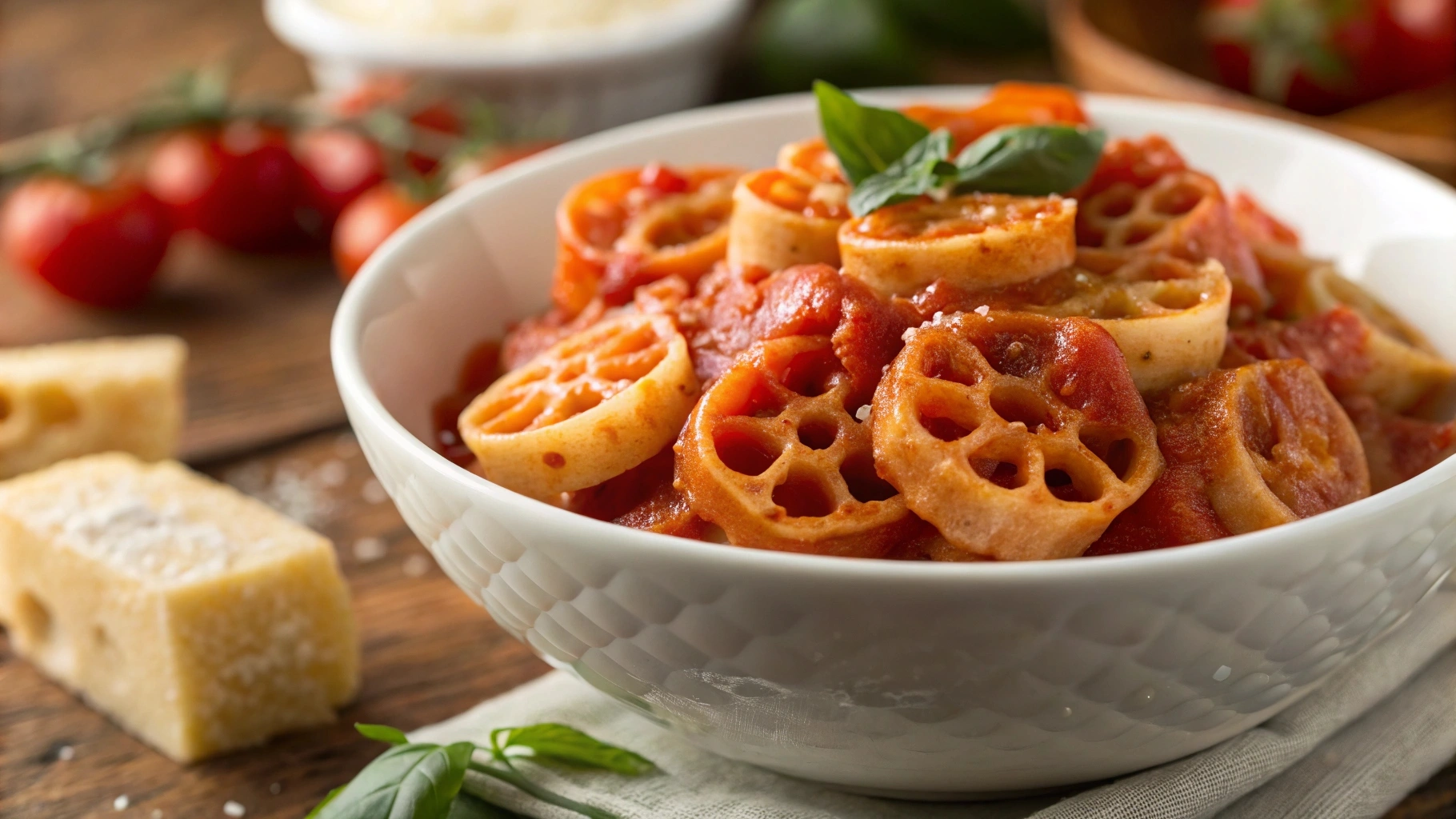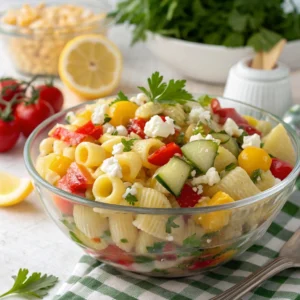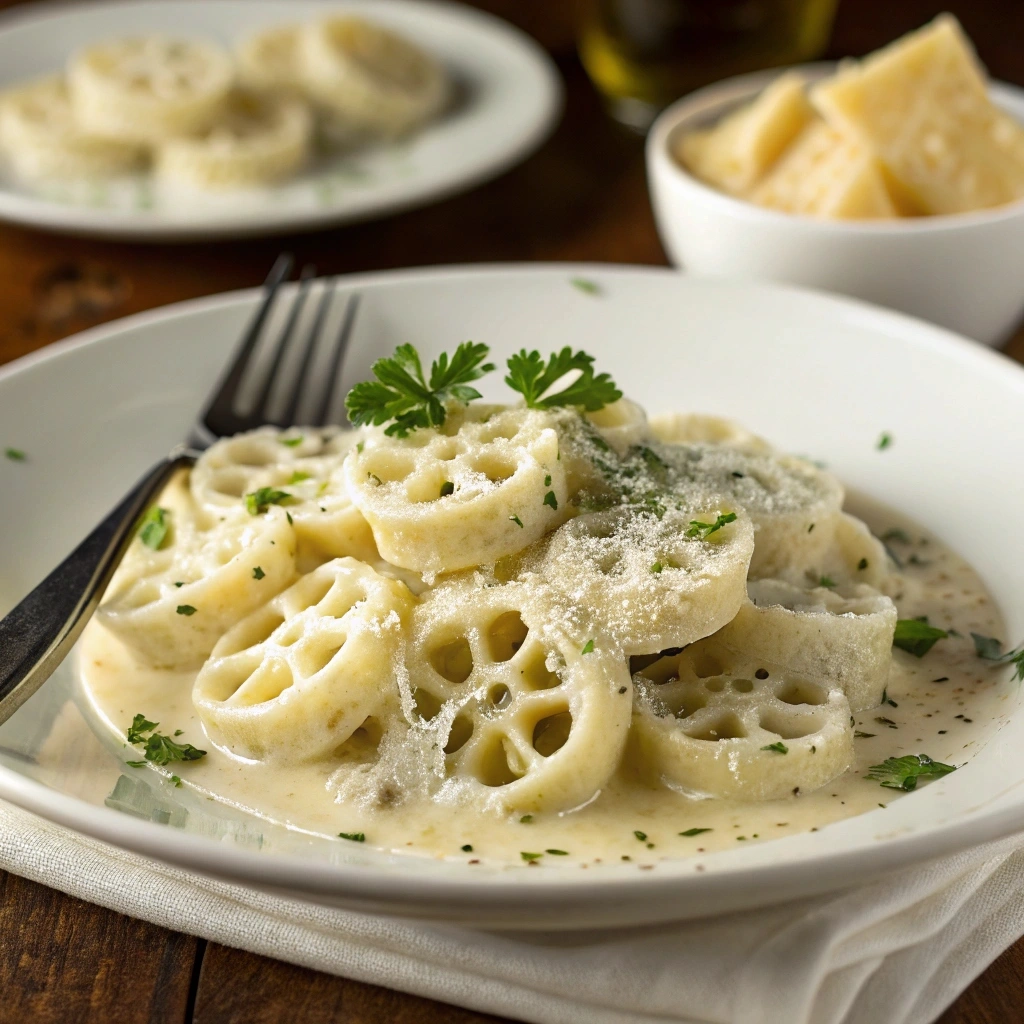Wheel pasta, also known as rotelle in Italian, is a delightful type of pasta that takes the shape of tiny wagon wheels. Its circular design, characterized by a central hub and evenly spaced spokes, makes it not just visually appealing but also practical for holding sauces and ingredients. This pasta is often used in soups, casseroles, and even cold pasta salads, thanks to its unique ability to blend texture with versatility.
The origins of wheel pasta are deeply rooted in Italy’s rich culinary history, where it was designed to reflect the innovation and craftsmanship of Italian culture. The shape is thought to be inspired by industrial advancements, symbolizing the ingenuity of human creativity while serving a functional purpose in the culinary world.
Loved by children and adults alike, wheel pasta’s playful shape makes it an instant hit at dinner tables. Its ridges and spokes ensure that every bite captures a perfect balance of sauce and flavor. This pasta variety has gained worldwide popularity for its charming design and adaptability, appealing to both seasoned chefs and casual cooks. Whether featured in hearty meals or light snacks, wheel pasta brings a touch of fun to traditional pasta dishes.
Varieties of Wheel Pasta
Wheel pasta comes in various forms, each offering unique characteristics and culinary uses. From traditional classics to modern adaptations, these varieties cater to diverse tastes and dietary needs.

Classic Pasta Wheels (Rotelle)
Classic pasta wheels, known as rotelle in Italian, are the most recognizable form of wheel pasta. With their medium size and perfectly spaced spokes, they are ideal for capturing rich sauces like marinara, Alfredo, or bolognese. Their sturdy structure makes them a great choice for baked pasta dishes, where they retain their shape and texture.
Typically made with semolina flour and water, rotelle is boiled to a tender yet firm texture (al dente) before being paired with sauces or included in casseroles. It’s also a favorite in kids’ meals due to its fun and playful design, often served with a simple butter or cheese sauce.
Mini Pasta Wheels
Mini pasta wheels are a smaller version of the classic rotelle, designed to add a whimsical touch to soups, broths, and salads. These petite wheels are particularly popular in Italian wedding soups and light vegetable dishes, where their delicate size enhances the overall presentation.
Their smaller diameter allows them to cook quickly, making them a practical choice for quick meals. Mini pasta wheels are also loved in cold pasta salads, as their small size pairs well with diced vegetables, dressings, and cheeses.
Gluten-Free
Gluten-free wheel pasta caters to individuals with dietary restrictions, such as celiac disease or gluten sensitivities. Made from alternative flours like rice, corn, or chickpea, these pasta options retain the familiar shape and texture of traditional wheels while offering a healthy alternative.
The benefits of gluten-free versions of this pasta shape extend beyond dietary restrictions. These options often provide higher protein content and cater to a variety of nutritional needs. They perform equally well in hot or cold recipes, allowing everyone to appreciate the appeal of this uniquely designed pasta, no matter their dietary requirements.
How to Cook Wheel Pasta Perfectly
Cooking wheel pasta is an art that combines precision and creativity. Whether you’re aiming for a hearty dish or a light salad, proper preparation ensures that every bite is flavorful and satisfying.
Step-by-Step Cooking Instructions
 Boiling Wheel Pasta
Boiling Wheel Pasta
Begin by bringing a large pot of water to a rolling boil. For every pound of pasta, use at least 4 quarts of water to prevent sticking. Add a generous pinch of salt to the water—this enhances the pasta’s natural flavor. Once boiling, add the wheel pasta and stir gently to separate the pieces.Cook the pasta according to the package instructions, usually 8–12 minutes, depending on the variety. For a firmer bite (al dente), test the pasta a minute or two before the recommended time.- Tips to Avoid Overcooking
Keep a close eye on the timer. Overcooked pasta becomes mushy, losing its structure and ability to hold sauces. Once cooked, immediately drain the pasta and rinse with cold water if using it for a salad or cold dish.
Best Sauces
- Tomato-Based Sauces
Robust tomato sauces like marinara or arrabbiata cling beautifully to wheel pasta, making each bite a burst of flavor. Add a sprinkle of Parmesan for extra richness. - Cream-Based Sauces
Alfredo or carbonara sauce pairs wonderfully with wheel pasta, filling its spokes with creamy goodness. - Pesto and Light Sauces
Basil pesto, olive oil, or lemon butter sauces enhance the pasta’s playful texture without overpowering its taste.
Common Mistakes to Avoid
- Overcooking
Overcooked pasta loses its firm, chewy texture. Stick to the timer and taste-test for doneness. - Under-Salting the Water
Unsalted water results in bland pasta. Properly seasoned water is key for flavorful results.
Recipes to Try
Wheel Pasta in Mac and Cheese
Wheel pasta’s unique shape holds cheese sauce impeccably, making it an excellent choice for mac and cheese. Combine a rich cheddar sauce with cooked pasta wheels, top with breadcrumbs, and bake for a golden, bubbling delight.
Wheel Pasta in Soups
Add cooked wheel pasta to brothy soups like minestrone or chicken noodle to introduce texture and substance. The wheels’ ridges soak up the broth, creating a satisfying bite.
Wheel Pasta Salad
For a refreshing dish, mix cooked and cooled wheel pasta with diced vegetables, olives, and feta cheese. Toss with a tangy vinaigrette for a light and flavorful pasta salad that’s perfect for picnics or quick meals.
Is Wheel Pasta Healthy?
Pasta, in its various forms, can be a healthy component of your diet when enjoyed in moderation and combined with wholesome ingredients. This particular variety, shaped like wheels, is crafted mainly from semolina flour, water, and occasionally eggs. It offers a reliable source of carbohydrates, an essential fuel for the body.
Nutritional Breakdown of Regular Wheel Pasta
A typical 2-ounce serving of dry wheel pasta contains approximately:
- Calories: 200–220
- Carbohydrates: 42–45 grams
- Protein: 7–8 grams
- Fat: 1 gram or less
Wheel pasta is also a source of essential nutrients like iron and B vitamins, which are often enriched during production. However, it is relatively low in fiber and lacks significant amounts of vitamins C, A, and other essential minerals, unless paired with nutrient-rich sauces and ingredients.
Caloric Content and Macronutrient Distribution
The calorie content of a dish depends largely on added ingredients, such as creamy sauces or high-fat toppings. Keeping portions moderate and opting for lean protein or vegetable-based additions can help maintain a balanced meal.
Healthier Alternatives
Whole Grain and Gluten-Free Options
For a more nutritious version of wheel pasta, consider whole-grain varieties. These options offer higher fiber content, which aids digestion and helps you feel fuller for longer. Gluten-free options, made from chickpea, lentil, or quinoa flour, are also healthier choices for those with gluten sensitivities, offering additional protein and micronutrients.
Tips to Make Wheel Pasta Dishes Healthier
- Pair wheel pasta with fresh vegetables like spinach, tomatoes, or zucchini to boost vitamin and mineral intake.
- Use olive oil, pesto, or tomato-based sauces instead of cream-based ones to reduce fat content.
- Add lean proteins such as grilled chicken, shrimp, or beans to create a balanced meal.
- Control portion sizes to avoid overindulgence and unnecessary calorie intake.
By choosing nutrient-dense ingredients and cooking methods, wheel pasta can easily be part of a wholesome and delicious meal.
Where to Buy Wheel Pasta
Wheel-shaped pasta is a staple in most grocery stores and can usually be found in the pasta or international foods aisle. Brands like Barilla, De Cecco, and Delallo offer high-quality options for pasta enthusiasts. For those seeking authentic flavors, specialty Italian markets often carry unique varieties that reflect traditional craftsmanship.
Online retailers such as Amazon, Walmart, and Target also stock a wide selection of pasta varieties, including gluten-free and whole-grain alternatives. For a more artisanal touch, some makers craft handcrafted versions, perfect for gourmet dishes and adventurous cooking.
How to Store Wheel Pasta
For Dried
Keep dried pasta in its original packaging or transfer it to an airtight container for longer-lasting freshness. Store it in a cool, dry location, away from heat and moisture, to preserve its quality. Properly stored, it can remain usable for up to two years.
For Cooked
Refrigerate cooked pasta wheels in a sealed container and consume them within 3–5 days. To prevent sticking, toss the pasta lightly in olive oil before storing. For longer-term storage, freeze it in airtight containers or freezer bags for up to 2 months. When ready to use, thaw and reheat as needed for convenient meals.
FAQs
What is wheel shaped pasta called?
Wheel-shaped pasta is commonly called rotelle in Italian, which translates to “little wheels.” Its unique design, resembling wagon wheels, makes it a favorite choice for a variety of dishes, from hearty soups to creamy baked casseroles.
What is the spinny pasta called?
The “spinny” pasta is likely a reference to rotini or fusilli, which are spiral-shaped pasta varieties. While they are not wheel-shaped, these pastas are often mistaken for rotelle due to their playful designs and ability to hold sauces well.
Is wheel a type of pasta?
Yes, wheel pasta, or rotelle, is a specific type of pasta. Its distinct circular shape with spokes is designed to trap sauces and other ingredients, making it a versatile choice for both savory and creative dishes.
Who makes wagon wheels pasta?
Many popular pasta brands produce wagon wheels pasta, including Barilla, De Cecco, and Great Value (Walmart’s brand). Additionally, specialty and gluten-free brands like Jovial and Banza offer wheel pasta options to cater to diverse dietary preferences. Check your local grocery store or online marketplaces to explore these options.
Delicious Dishes to Pair
- Do Steak and Pasta Go Together?
For a hearty and satisfying combination, consider pairing wheel pasta with steak. The unique texture of wheel pasta beautifully complements the rich flavors of a perfectly cooked steak. Discover more ideas and inspiration for combining steak and pasta - Cajun Shrimp Pasta
Wheel pasta’s shape is ideal for holding bold sauces like Cajun seasonings. This combination brings a unique twist to traditional Cajun Shrimp Pasta recipes. For a flavorful spin, check out this Cajun Shrimp Pasta recipe. - Steak Pasta
Elevate your wheel pasta dishes by pairing them with tender steak and savory sauces. This fusion is perfect for pasta lovers who enjoy indulgent flavors. Explore creative ideas and recipes for steak pasta .
Conclusion
Wheel-shaped pasta is a delightful and versatile option that combines both charm and practicality in your meals. Its distinctive design excels at capturing sauces, adding texture to soups, and enhancing the presentation of salads. Whether you enjoy classic Italian recipes or experimenting with modern dishes, this playful pasta shape adapts beautifully to any culinary style.
Experimenting with wheel pasta allows you to explore a range of flavors and cooking styles, making it a great addition to your pantry. Give it a try, and enjoy the charm and versatility of this beloved pasta in your next dish!

